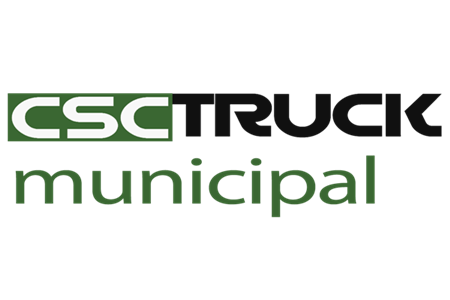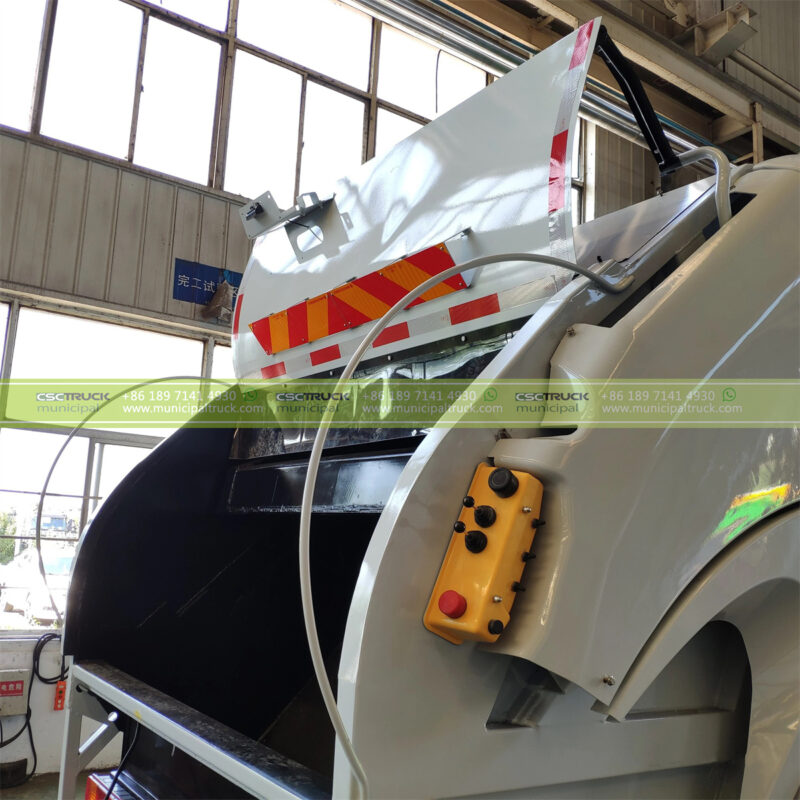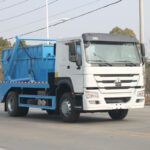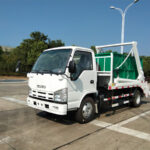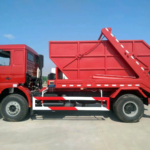In the world of waste management, efficiency and versatility are critical for handling the sheer volume of refuse generated daily by households and businesses. Rear loader garbage trucks have long been a staple in municipal and private waste collection fleets, offering a reliable method for gathering and transporting bulk waste. Unlike front loaders or automated side loaders, these trucks are specifically designed to manage large, irregularly shaped items—from furniture to yard waste—making them indispensable in urban and suburban settings. This article explores the mechanics of rear loaders, their operational advantages, and how they compare to specialized alternatives like skip loader garbage trucks and compactor garbage trucks in managing diverse waste streams.
1. The Mechanics of a Rear Loader Garbage Truck
Rear loader garbage trucks operate on a simple yet highly effective principle: manual or semi-automated loading from the back, followed by compaction to maximize hauling capacity.
Key Components and Their Functions
- Hopper and Loading Chamber: Workers deposit waste directly into an open hopper at the rear, which feeds into a large storage compartment.
- Hydraulic Packing Blade: A powerful blade compresses waste against the truck’s interior wall, increasing payload capacity by up to three times compared to uncompacted loads.
- Ejection System: Once full, the truck uses a hydraulic mechanism to push the compacted waste out at the disposal site.
Handling Bulk Waste Efficiently
Unlike curbside bins serviced by automated trucks, rear loaders excel at collecting:
- Bulky items (mattresses, appliances, furniture)
- Loose yard waste (branches, leaves, grass clippings)
- Construction debris (non-hazardous materials like wood and drywall)
Their design allows for manual loading flexibility, making them ideal for areas where waste generation is unpredictable or includes oversized materials.
2. Operational Advantages in Urban and Suburban Areas
While automated trucks dominate standardized residential routes, rear loader garbage trucks provide unmatched adaptability in varied environments.
Versatility in Collection
- No bin dependency: Workers can load items of any size directly into the hopper.
- Mixed waste capability: Unlike recycling-specific trucks, rear loaders handle general refuse, organic waste, and light debris in a single run.
Labor and Cost Efficiency
- Reduced pre-sorting need: Unlike compactor garbage trucks, which often require segregated waste streams, rear loaders accept commingled materials.
- Lower infrastructure costs: No requirement for specialized bins or robotic arms, making them cost-effective for municipalities with limited budgets.
However, their reliance on manual labor means they are less efficient than fully automated systems for high-density, uniform waste collection.
3. Comparing Rear Loaders to Specialized Waste Trucks
While rear loaders are highly versatile, certain scenarios call for more specialized vehicles.
Vs. Skip Loader Garbage Trucks
- Skip loaders excel at handling large, containerized waste (e.g., construction dumpsters) but lack compaction capabilities.
- Rear loaders are better suited for loose, bulky items that don’t fit into skips.
Vs. Compactor Garbage Trucks
- Compactors provide higher density compression for commercial and industrial waste but require pre-loaded containers.
- Rear loaders allow direct dumping, making them preferable for residential bulk waste.
In practice, many fleets use a combination—rear loaders for curbside bulk collection and compactor garbage trucks for high-volume commercial disposal.
4. Maintenance and Longevity Considerations
The rugged design of rear loader garbage trucks ensures durability, but proper upkeep is essential.
Common Maintenance Needs
- Hydraulic system checks to prevent packing blade failures.
- Hopper wear plates replacement due to constant abrasion from heavy debris.
- Frequent lubrication of moving parts to sustain compaction efficiency.
When maintained well, these trucks can last 10–15 years, outperforming many automated models in heavy-duty applications.
5. The Future of Rear Loader Technology
Innovations are enhancing rear loaders’ efficiency and environmental impact.
Automation Integration
- Semi-automatic lifters reduce physical strain on workers while retaining loading flexibility.
- AI-powered load sensors optimize compaction rates in real time.
Eco-Friendly Upgrades
- Electric and hybrid models reducing emissions in urban zones.
- Advanced filtration systems minimizing particulate release during compaction.
While skip loader garbage trucks and compactor garbage trucks dominate niche segments, rear loaders remain vital for their unmatched bulk waste handling, proving that sometimes, the best solution is a blend of manpower and mechanical ingenuity.
For waste managers, the choice ultimately depends on the balance between labor availability, waste type, and route efficiency, but for bulk refuse, the rear loader garbage truck continues to be a workhorse that gets the job done.
